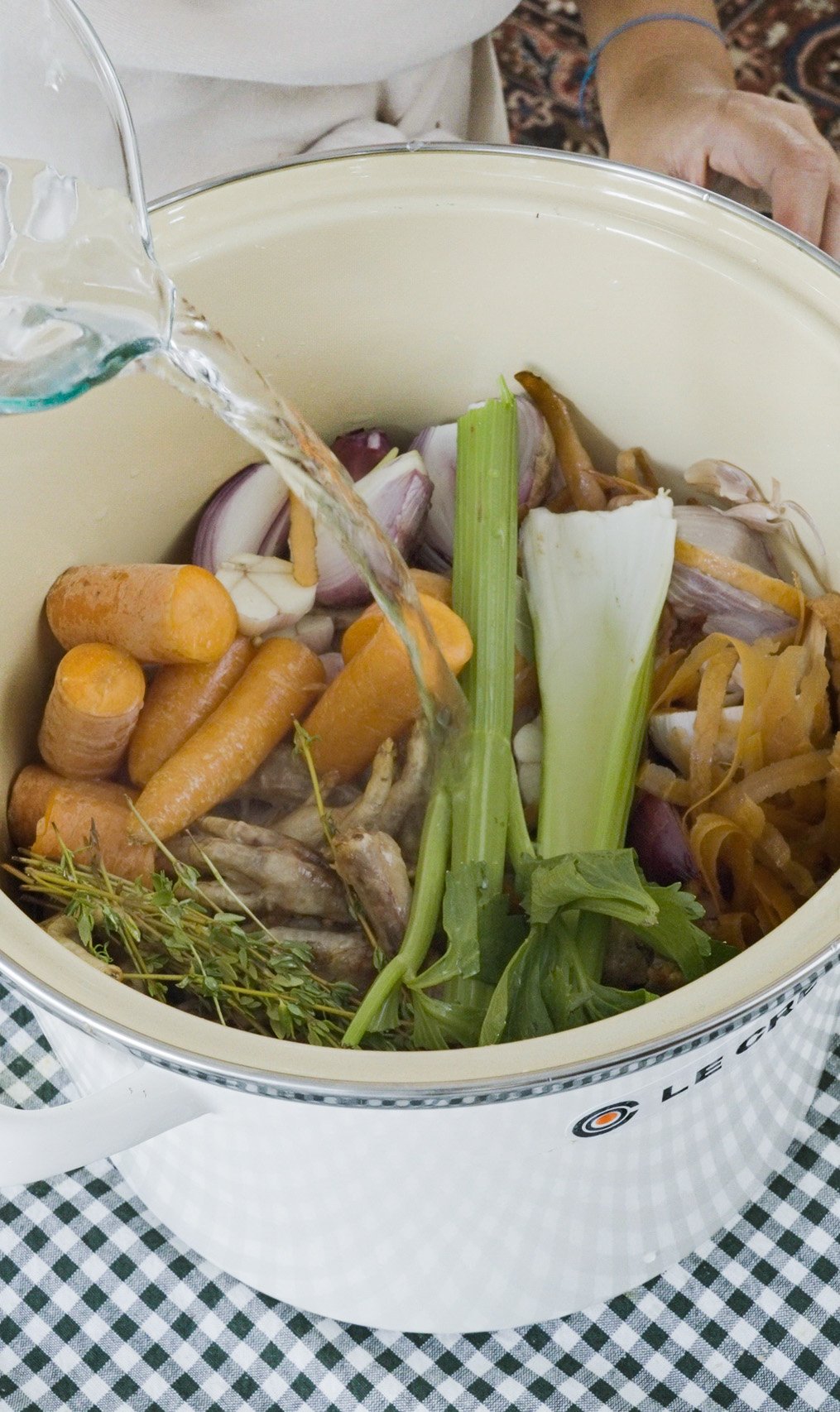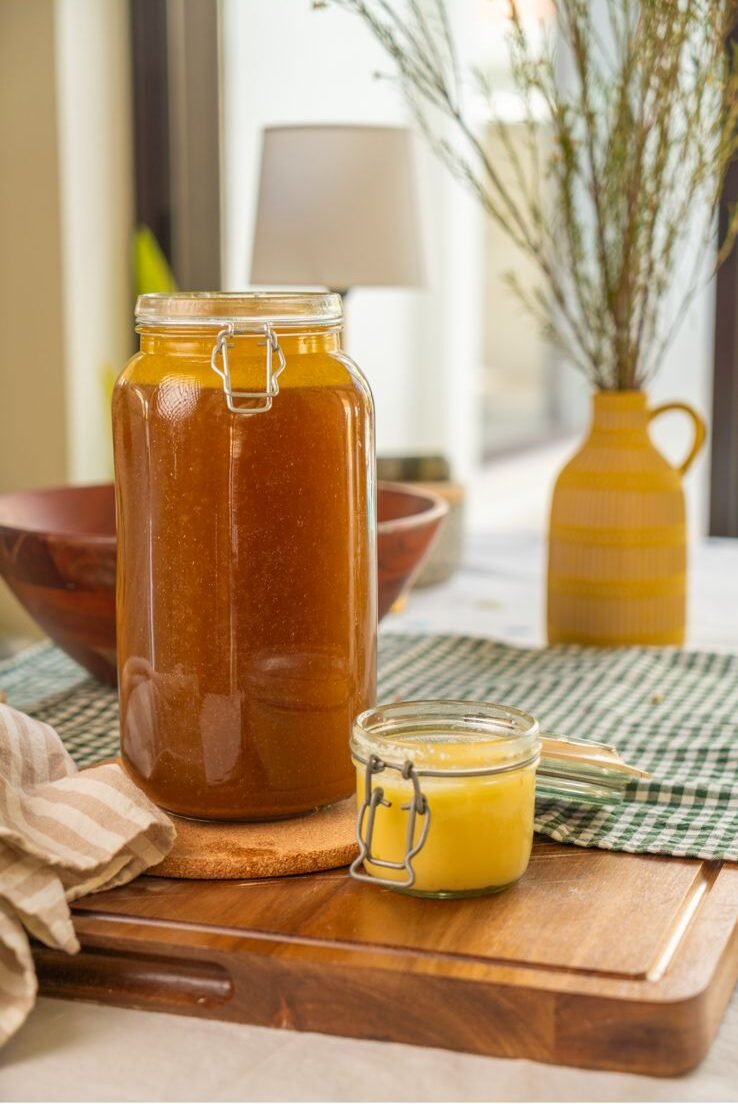At MKitchen Tales, we’re all about nutrient-dense, wholesome meals that nourish the body from the inside out. One of my favorite kitchen staples is bone broth—specifically collagen-rich chicken bone broth. This broth is packed with goodness, offering a slightly milder flavor compared to beef bone broth, but still delivering all the health benefits. It’s rich in collagen, minerals, and gelatin, which are essential for strong bones, healthy skin, and a well-functioning gut.
When I make chicken bone broth, I always add chicken feet. Chicken feet are an amazing source of collagen and gelatin, making the broth even richer and more nourishing. I often use this broth as a base for soups, as a cooking liquid for rice, or even as a drink on its own—especially when I make noodle soup for the kids. It’s a versatile, nutrient-packed addition to my family’s meals.
Here’s how I make this delicious, healing chicken bone broth, and why you should consider adding chicken feet to your broth-making routine.

Collagen-Rich Chicken Bone Broth with Chicken Feet
Ingredients:
- 6 chicken carcasses (or adjust the quantity based on the size of your pot)
- 10-12 chicken feet (the more feet, the richer the broth)
- 2-3 large carrots, roughly chopped
- 2 celery stalks, roughly chopped
- 1 large onion, quartered (no need to peel)
- 4 garlic cloves, smashed (no need to peel)
- A bunch of vegetable scraps (e.g., leek tops, potato skins, stems from herbs, etc.)
- 1-2 tbsp apple cider vinegar (helps extract minerals from the bones)
- 1 tbsp whole peppercorns
- 1-2 tbsp coriander seeds
- 2 bay leaves
- A few sprigs of fresh thyme (optional)
- A handful of fresh basil (optional)
- Salt to taste (add at the end)
Directions:
- Preheat the Oven for Chicken Feet:
- Preheat your oven to 400°F (200°C).
- While the oven is heating up, prepare the chicken carcasses and feet for the broth.
- Prepare Chicken Carcasses:
- Place the chicken carcasses into your pot. If you have a larger pot, you can fit more carcasses in, but if you’re using a smaller pot, reduce the amount to suit your size.
- Roast the Chicken Feet:
- Arrange the chicken feet on a baking sheet and place them in the oven. Roast for about 30 minutes, flipping halfway through for even charring.
- Deglaze the Baking Sheet:
- Once roasted, remove the feet from the oven. Pour some water or broth into the baking sheet and scrape up any flavorful bits. Add this liquid to the pot with the carcasses.
- Add Vegetables and Scraps:
- Add the chopped carrots, celery, onion, garlic, and vegetable scraps. I collect vegetable scraps throughout the week—things like leek tops, carrot peels, and potato skins—and use them in my broths. It really helps boost the nutritional content, and since most of my veggies are organic, I wash them thoroughly and use all the skins. This adds a great deal of minerals and vitamins to the broth.
- Add Herbs and Seasonings:
- Toss in the bay leaves, thyme, basil, peppercorns, coriander seeds, and apple cider vinegar. The vinegar helps draw out minerals from the bones and feet.
- Fill the Pot with Water:
- Add enough cold water to cover all the ingredients. Usually, about 10-12 cups, depending on the size of your pot.
- Bring to a Boil:
- Bring the pot to a boil over high heat. Once boiling, reduce the heat quickly to a simmer. Skim any impurities or foam that rise to the top.
- Simmer for 12 Hours:
- Partially cover the pot and let it simmer gently for at least 12 hours. You can simmer it even longer if you prefer a more concentrated flavor. I often leave it cooking overnight or for a full day for maximum nutrients.
- Strain and Season:
- Once your broth has simmered and the flavors have melded together, strain out the solids using a fine mesh strainer or cheesecloth. Taste the broth and add salt or additional seasoning as needed.

Why Chicken Feet?
Chicken feet are a powerhouse when it comes to collagen production. They contain a high amount of collagen and gelatin, which are crucial for joint and skin health. Collagen is what helps keep our skin elastic, our joints flexible, and our bones strong. The gelatin that forms in the broth from the chicken feet gives it a beautiful, silky texture, and it’s this gelatin that is so beneficial for gut health, as it helps heal and seal the digestive tract.
Aside from collagen, chicken feet are also rich in calcium, magnesium, phosphorus, and other essential minerals that support bone health and overall vitality.
How I Use My Bone Broth
My kids drink this broth as a base for their noodle soups, and I use it for almost all of my soups and stews. It also makes a great base for cooking rice—just replace the water with broth, and you’ll have a more flavorful, nutrient-dense dish. When I make soups or cook rice, I always reach for my homemade bone broth because it gives everything a richer taste and provides healing benefits with every spoonful.
Broth-Making Tip: What Not to Use
If you’re new to making broths, be sure to check out my post on What Not to Use in Broth—certain vegetables can turn your broth bitter or affect the taste and texture. For example, avoid using cruciferous vegetables like broccoli, cauliflower, Brussels sprouts, and cabbage, as they can make the broth overly bitter. Stick to nutrient-rich vegetables like carrots, onions, and celery for a balanced, flavorful broth.
Final Thoughts
Making bone broth is not only a fantastic way to utilize every part of the chicken (or beef) but also a simple method of boosting the nutrition in your meals. With chicken feet, you’re truly getting the most out of your ingredients, while creating a deeply nourishing, collagen-packed broth that your family will love.
Happy broth making, and don’t forget to use your vegetable scraps—they’re a great way to add vitamins and minerals while reducing food waste.
Cheers to wholesome, nourishing homemade broths!







Responses